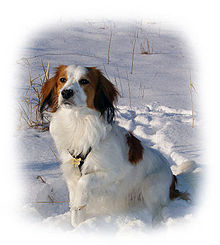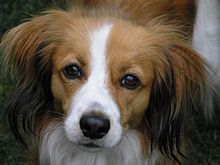- Kooikerhondje
-
Kooikerhondje 
A two-year-old Kooikerhondje. Other names Kooiker Hound
Small Dutch Waterfowl Dog
Dutch Decoy Dog
Kooiker Dog
KooikerhondjeNicknames Kooiker Country of origin Netherlands Traits Classification and standards FCI Group 8 Section 2 #314 standard AKC Sporting (FSS) standard The AKC Foundation Stock Service (FSS) is an optional recording service for purebred dogs that are not yet eligible for AKC registration. KC (UK) Gundog standard UKC Gun Dog standard Dog (Canis lupus familiaris) The Kooikerhondje or Kooiker Hound, is a small spaniel-type breed of dog of Dutch ancestry that was originally used as a working dog, particularly in duck hunting and tolling. Kooikers were popular in the 17th and 18th century and appeared in the paintings of Rembrandt and Jan Steen. The breed is rapidly gaining popularity in the United States, Canada and Scandinavia, where it is still relatively unknown.
Contents
Description
Appearance
These dogs are around 35 to 40 cm (14 to 16 inches) high at the withers with a nearly square body that is slightly longer than their height at the shoulders. Depending on the gender and the size a Kooikerhondje is not supposed to weigh more than 9-11 kilograms.[1] They have medium long, hanging ears with wispy tips, known as earrings [2], that are set close to the head and they have long, feathered tails with a white plume. The breed has a waterproof, medium long coat that doesn't hold much dirt and is easily cleaned by a simple brushing.[1] They have shiny bicoloured coats, often predominantly white with orange-red plates. The fur is medium long and either slightly wavy or straight. For conformation showing, dogs with black ear tips and white tails are preferred.
Temperament
Cheerful, good natured, friendly, quiet, well-behaved, and alert; those are terms that are used to describe the Kooikerhondje. It is dependent on its domestic environment[3], kind, happy and lively. They are also intelligent, attentive and more than willing to please their owner. The Kooikerhondje adapts to situations rather quickly, changing his behavior from quiet to lively when the situation allows him to be. He will not always immediately like strangers, instead choosing to retreat. But once he warms up to someone, the trust will be there for the rest of his life.[1]
Health
Kooikers have good appetites and a tendency to put on weight easily. They have a relatively small genetic base, so hereditary diseases were earlier somewhat prevalent. These include:
- von Willebrand's disease, a blood clotting disorder [4]
- Cataract and other eye diseases [4]
- Patellar luxation [4]
Today (due to a lot of hard work in the national clubs) most Kooikers used for breeding are free from von Willebrands disease (most national clubs require both male and female dogs to be free from this disease to be allowed to breed). Patellar luxation is no major problem in most countries at the moment, but is kept under a close watch to prevent it from becoming a problem again. In the Netherlands, eye tests are available and all breeders breeding according to the breed club's rules have to test their dogs. Only dogs that are free of eye diseases are allowed to be used for breeding.[4]
History
The Kooikerhondje was developed in the Netherlands around the sixteenth century to be a tolling breed. They were used to lure and drive ducks into 'kooien' (cages in the form of canals with traps at the ends), where the hunter (the so called Kooiker) could easily catch the fowl. The dogs that were used by the Kooiker for this kind of hunting technique, were referred to as the 'Kooiker's hondjes' (literally: Kooiker's dogs). Eventually this led to this dog being called Kooikerhondje.
The breed almost became extinct after World War II until Baroness van Hardenbroek van Ammerstol rescued it. The breed was only officially recognized by the Raad van Beheer[5], the Dutch Kennel Club, in 1971[6] and has since been imported into other countries and recognised officially. The breed is still relatively unknown in North America and not yet recognized as a breed in the USA or Canada, although it has been accepted into the AKC's FSS program[7] and is assigned into the Sporting Group.[8] In the United States, both the UKC and ARBA recognize the breed.
In the UK, the breed has been removed from the import list and is now eligible to enter Crufts for the Best in Show award, despite there being only 76 of the breed in the UK.
Some historians believe the Kooikerhondje may have possibly played a part in the development of the Nova Scotia Duck-Tolling Retriever.References
- ^ a b c Vereniging het Nederlandse Kooikerhondje (EN), Dutch Kooikerhondje Club, describing the breed
- ^ Dogs 101: Kooikerhondje
- ^ Vereniging het Nederlandse Kooikerhondje (EN), Dutch Kooikerhondje Club, official breed standard
- ^ a b c d Vereniging het Nederlandse Kooikerhondje (NL), Dutch Kooikerhondje Club, section purchase and health
- ^ Raad van Beheer (EN), Dutch Kennel Club
- ^ Vereniging het Nederlandse Kooikerhondje (NL), Dutch Kooikerhondje Club, history
- ^ Foundation Stock Service (EN), American Kennel Club Foundation Stock Service
- ^ "AKC Kooikerhondje Did You Know?". http://https://www.akc.org/breeds/kooikerhondje/. Retrieved 11 September 2011.
External links
Spaniels Extant American Cocker · American Water · Blue Picardy · Boykin · Brittany · Cavalier King Charles · Clumber · Drentse Patrijshond · English Cocker · English Springer · Field · French · German · Irish Water · King Charles · Kooikerhondje · Large Münsterländer · Papillon · Phalène · Picardy · Pont-Audemer · Russian · Saint Usuge · Small Münsterländer · Sussex · Welsh SpringerExtinct Misnamed Breeds of gundog Pointers English Setter · Gordon Setter · Irish Red and White Setter · Irish Setter · Llewellin Setter · PointerVersatile gundogs Ariege Pointer · Blue Picardy Spaniel · Bracco Italiano · Braque du Bourbonnais · Braque d'Auvergne · Braque Français · Braque Saint-Germain · Brittany · Burgos Pointer · Cesky Fousek · Drentsche Patrijshond · German Longhaired Pointer · German Shorthaired Pointer · German Wirehaired Pointer · Münsterländer (Large) · Münsterländer (Small) · Old Danish Pointer · Pachón Navarro · Picardy Spaniel · Portuguese Pointer · Pudelpointer · Slovakian Rough Haired Pointer · Spinone Italiano · Vizsla · Weimaraner · Wirehaired Pointing GriffonRetrievers Spaniels Water dogs American Water Spaniel · Barbet · Cantabrian Water Dog · Irish Water Spaniel · Lagotto Romagnolo · Poodle · Portuguese Water Dog · Spanish Water Dog · WetterhounCategories:- Spaniels
- Dog breeds
- Sporting dogs
- Dog breeds originating in the Netherlands
- Rare dog breeds
Wikimedia Foundation. 2010.


